HA3011 Advanced Financial Accounting Report: SCA Property Group
VerifiedAdded on 2023/03/31
|12
|2605
|428
Report
AI Summary
This report examines the application of advanced financial accounting principles, focusing on the case of SCA Property Group. It begins with an introduction to accounting concepts and the importance of a conceptual framework, followed by a detailed analysis of SCA Property's accounting practices. The report covers key aspects such as compliance with Australian Accounting Standards (AASB), the use of historical cost, and the going concern principle. It delves into the conceptual framework, including elements of financial statements and the issues related to accounting standards that are not yet effective. Specific attention is given to financial instruments (AASB 9) and revenue recognition (AASB 15). The report also assesses the qualitative characteristics of financial statements, including representational faithfulness and relevance, and concludes with an overview of the company's financial reporting practices.
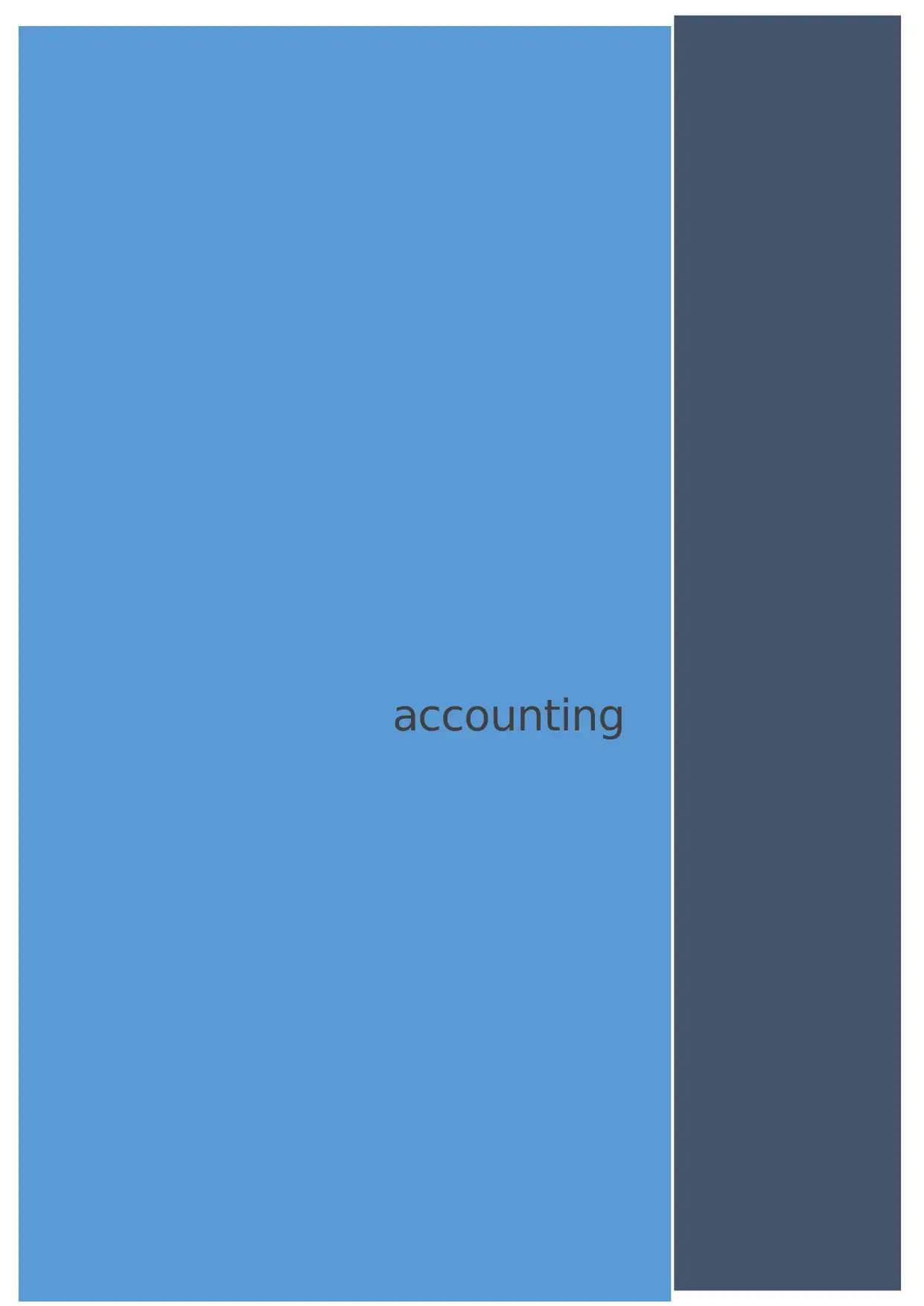
accounting
Paraphrase This Document
Need a fresh take? Get an instant paraphrase of this document with our AI Paraphraser
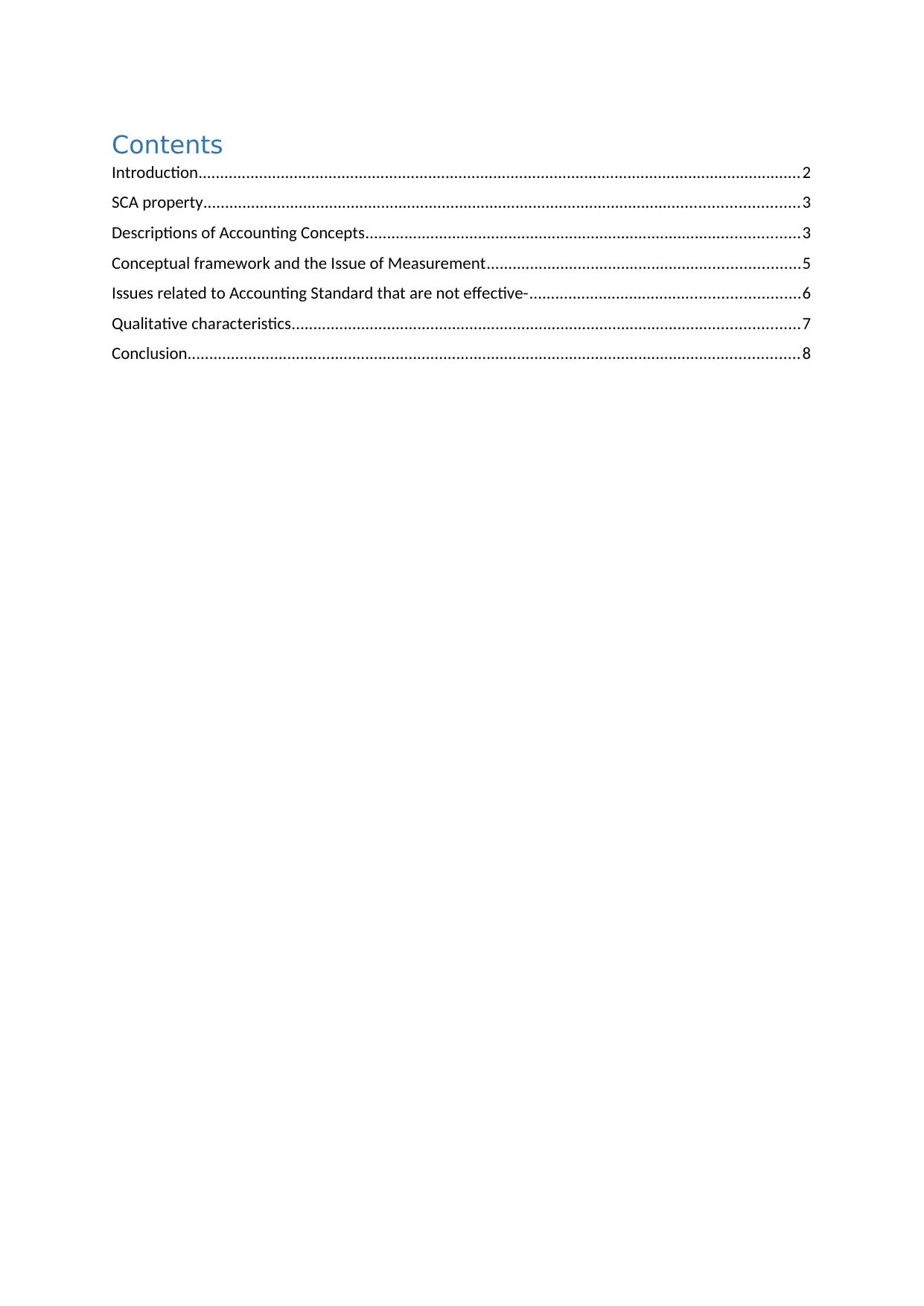
Contents
Introduction...........................................................................................................................................2
SCA property.........................................................................................................................................3
Descriptions of Accounting Concepts....................................................................................................3
Conceptual framework and the Issue of Measurement........................................................................5
Issues related to Accounting Standard that are not effective-..............................................................6
Qualitative characteristics.....................................................................................................................7
Conclusion.............................................................................................................................................8
Introduction...........................................................................................................................................2
SCA property.........................................................................................................................................3
Descriptions of Accounting Concepts....................................................................................................3
Conceptual framework and the Issue of Measurement........................................................................5
Issues related to Accounting Standard that are not effective-..............................................................6
Qualitative characteristics.....................................................................................................................7
Conclusion.............................................................................................................................................8
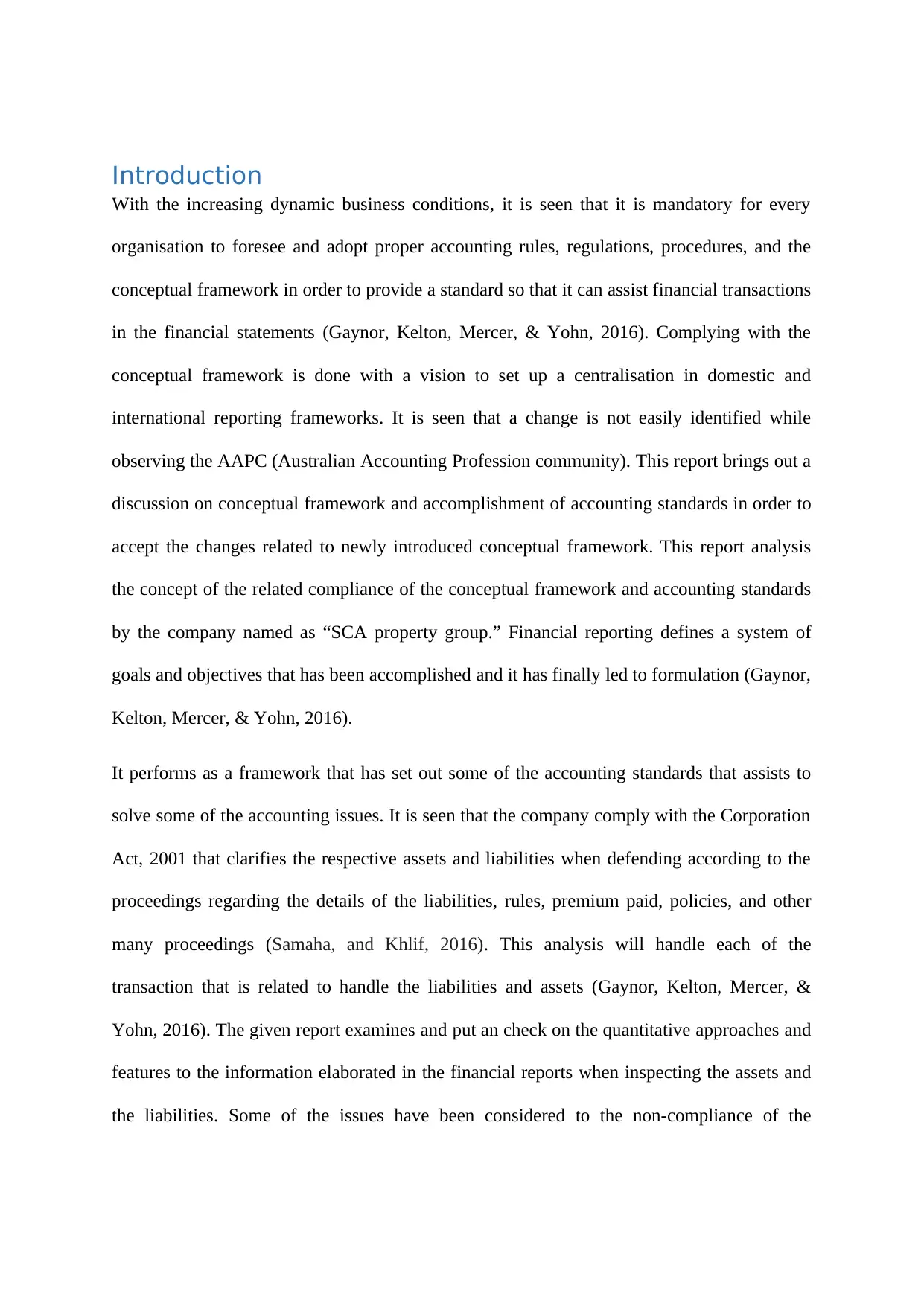
Introduction
With the increasing dynamic business conditions, it is seen that it is mandatory for every
organisation to foresee and adopt proper accounting rules, regulations, procedures, and the
conceptual framework in order to provide a standard so that it can assist financial transactions
in the financial statements (Gaynor, Kelton, Mercer, & Yohn, 2016). Complying with the
conceptual framework is done with a vision to set up a centralisation in domestic and
international reporting frameworks. It is seen that a change is not easily identified while
observing the AAPC (Australian Accounting Profession community). This report brings out a
discussion on conceptual framework and accomplishment of accounting standards in order to
accept the changes related to newly introduced conceptual framework. This report analysis
the concept of the related compliance of the conceptual framework and accounting standards
by the company named as “SCA property group.” Financial reporting defines a system of
goals and objectives that has been accomplished and it has finally led to formulation (Gaynor,
Kelton, Mercer, & Yohn, 2016).
It performs as a framework that has set out some of the accounting standards that assists to
solve some of the accounting issues. It is seen that the company comply with the Corporation
Act, 2001 that clarifies the respective assets and liabilities when defending according to the
proceedings regarding the details of the liabilities, rules, premium paid, policies, and other
many proceedings (Samaha, and Khlif, 2016). This analysis will handle each of the
transaction that is related to handle the liabilities and assets (Gaynor, Kelton, Mercer, &
Yohn, 2016). The given report examines and put an check on the quantitative approaches and
features to the information elaborated in the financial reports when inspecting the assets and
the liabilities. Some of the issues have been considered to the non-compliance of the
With the increasing dynamic business conditions, it is seen that it is mandatory for every
organisation to foresee and adopt proper accounting rules, regulations, procedures, and the
conceptual framework in order to provide a standard so that it can assist financial transactions
in the financial statements (Gaynor, Kelton, Mercer, & Yohn, 2016). Complying with the
conceptual framework is done with a vision to set up a centralisation in domestic and
international reporting frameworks. It is seen that a change is not easily identified while
observing the AAPC (Australian Accounting Profession community). This report brings out a
discussion on conceptual framework and accomplishment of accounting standards in order to
accept the changes related to newly introduced conceptual framework. This report analysis
the concept of the related compliance of the conceptual framework and accounting standards
by the company named as “SCA property group.” Financial reporting defines a system of
goals and objectives that has been accomplished and it has finally led to formulation (Gaynor,
Kelton, Mercer, & Yohn, 2016).
It performs as a framework that has set out some of the accounting standards that assists to
solve some of the accounting issues. It is seen that the company comply with the Corporation
Act, 2001 that clarifies the respective assets and liabilities when defending according to the
proceedings regarding the details of the liabilities, rules, premium paid, policies, and other
many proceedings (Samaha, and Khlif, 2016). This analysis will handle each of the
transaction that is related to handle the liabilities and assets (Gaynor, Kelton, Mercer, &
Yohn, 2016). The given report examines and put an check on the quantitative approaches and
features to the information elaborated in the financial reports when inspecting the assets and
the liabilities. Some of the issues have been considered to the non-compliance of the
⊘ This is a preview!⊘
Do you want full access?
Subscribe today to unlock all pages.

Trusted by 1+ million students worldwide
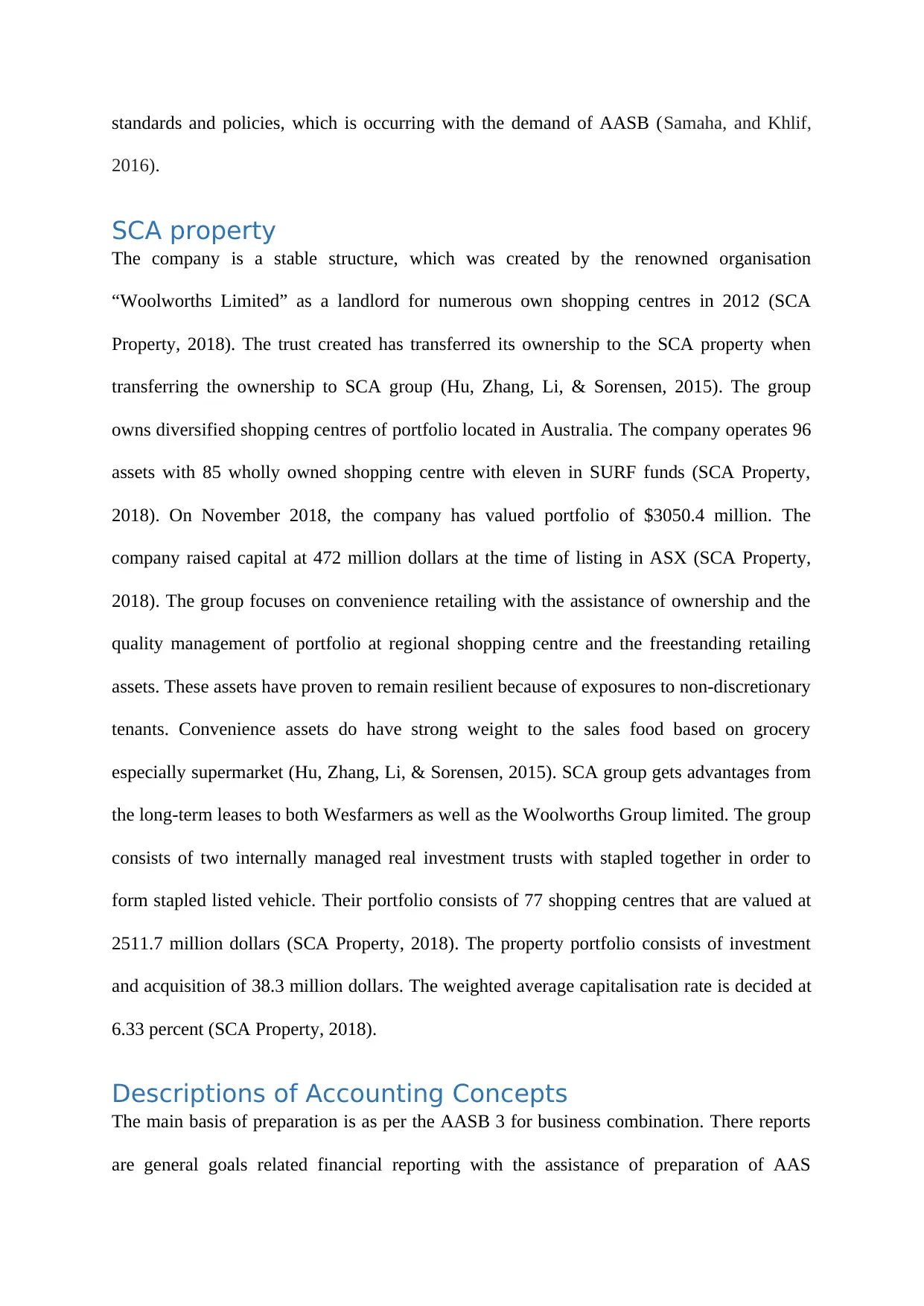
standards and policies, which is occurring with the demand of AASB (Samaha, and Khlif,
2016).
SCA property
The company is a stable structure, which was created by the renowned organisation
“Woolworths Limited” as a landlord for numerous own shopping centres in 2012 (SCA
Property, 2018). The trust created has transferred its ownership to the SCA property when
transferring the ownership to SCA group (Hu, Zhang, Li, & Sorensen, 2015). The group
owns diversified shopping centres of portfolio located in Australia. The company operates 96
assets with 85 wholly owned shopping centre with eleven in SURF funds (SCA Property,
2018). On November 2018, the company has valued portfolio of $3050.4 million. The
company raised capital at 472 million dollars at the time of listing in ASX (SCA Property,
2018). The group focuses on convenience retailing with the assistance of ownership and the
quality management of portfolio at regional shopping centre and the freestanding retailing
assets. These assets have proven to remain resilient because of exposures to non-discretionary
tenants. Convenience assets do have strong weight to the sales food based on grocery
especially supermarket (Hu, Zhang, Li, & Sorensen, 2015). SCA group gets advantages from
the long-term leases to both Wesfarmers as well as the Woolworths Group limited. The group
consists of two internally managed real investment trusts with stapled together in order to
form stapled listed vehicle. Their portfolio consists of 77 shopping centres that are valued at
2511.7 million dollars (SCA Property, 2018). The property portfolio consists of investment
and acquisition of 38.3 million dollars. The weighted average capitalisation rate is decided at
6.33 percent (SCA Property, 2018).
Descriptions of Accounting Concepts
The main basis of preparation is as per the AASB 3 for business combination. There reports
are general goals related financial reporting with the assistance of preparation of AAS
2016).
SCA property
The company is a stable structure, which was created by the renowned organisation
“Woolworths Limited” as a landlord for numerous own shopping centres in 2012 (SCA
Property, 2018). The trust created has transferred its ownership to the SCA property when
transferring the ownership to SCA group (Hu, Zhang, Li, & Sorensen, 2015). The group
owns diversified shopping centres of portfolio located in Australia. The company operates 96
assets with 85 wholly owned shopping centre with eleven in SURF funds (SCA Property,
2018). On November 2018, the company has valued portfolio of $3050.4 million. The
company raised capital at 472 million dollars at the time of listing in ASX (SCA Property,
2018). The group focuses on convenience retailing with the assistance of ownership and the
quality management of portfolio at regional shopping centre and the freestanding retailing
assets. These assets have proven to remain resilient because of exposures to non-discretionary
tenants. Convenience assets do have strong weight to the sales food based on grocery
especially supermarket (Hu, Zhang, Li, & Sorensen, 2015). SCA group gets advantages from
the long-term leases to both Wesfarmers as well as the Woolworths Group limited. The group
consists of two internally managed real investment trusts with stapled together in order to
form stapled listed vehicle. Their portfolio consists of 77 shopping centres that are valued at
2511.7 million dollars (SCA Property, 2018). The property portfolio consists of investment
and acquisition of 38.3 million dollars. The weighted average capitalisation rate is decided at
6.33 percent (SCA Property, 2018).
Descriptions of Accounting Concepts
The main basis of preparation is as per the AASB 3 for business combination. There reports
are general goals related financial reporting with the assistance of preparation of AAS
Paraphrase This Document
Need a fresh take? Get an instant paraphrase of this document with our AI Paraphraser
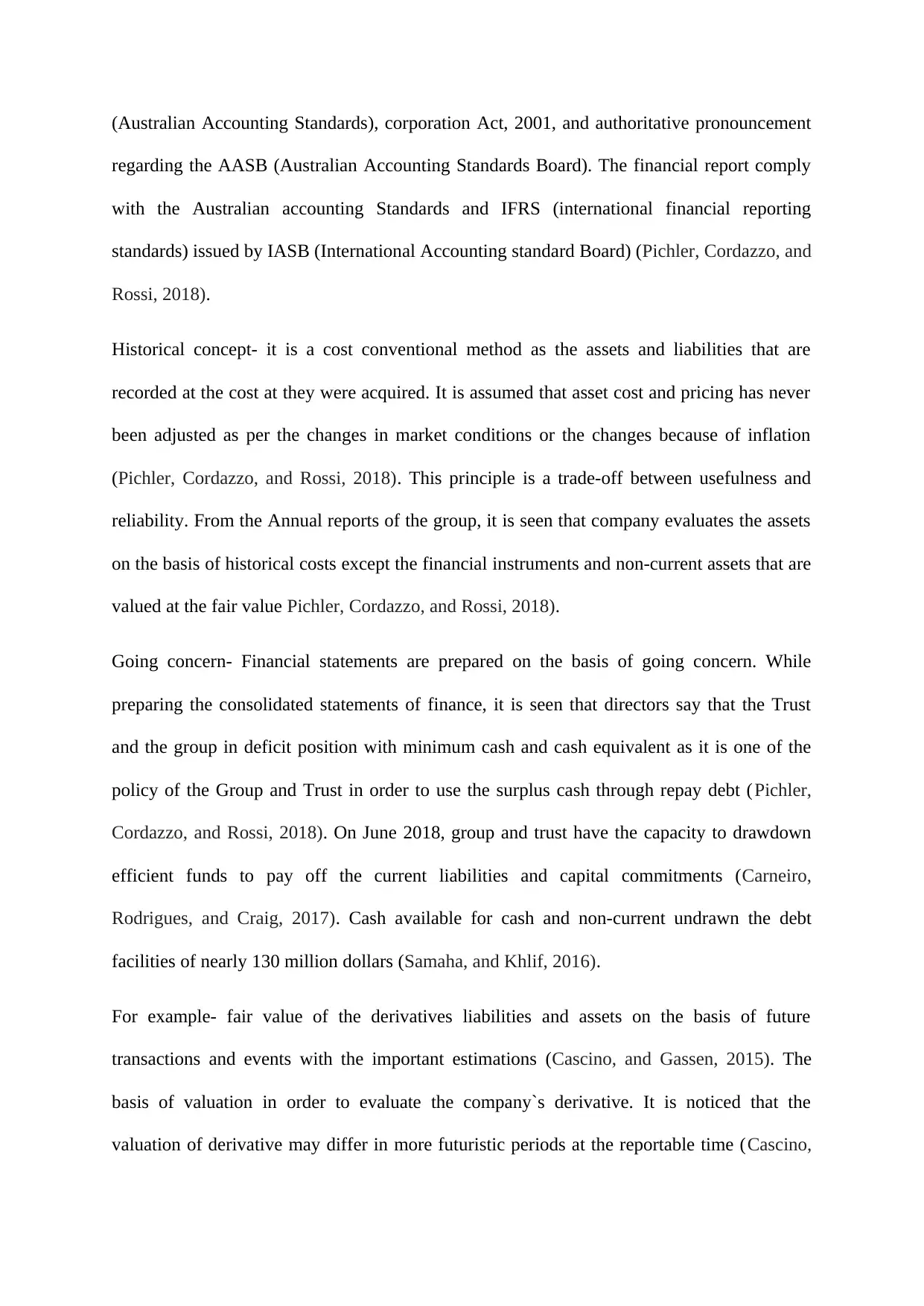
(Australian Accounting Standards), corporation Act, 2001, and authoritative pronouncement
regarding the AASB (Australian Accounting Standards Board). The financial report comply
with the Australian accounting Standards and IFRS (international financial reporting
standards) issued by IASB (International Accounting standard Board) (Pichler, Cordazzo, and
Rossi, 2018).
Historical concept- it is a cost conventional method as the assets and liabilities that are
recorded at the cost at they were acquired. It is assumed that asset cost and pricing has never
been adjusted as per the changes in market conditions or the changes because of inflation
(Pichler, Cordazzo, and Rossi, 2018). This principle is a trade-off between usefulness and
reliability. From the Annual reports of the group, it is seen that company evaluates the assets
on the basis of historical costs except the financial instruments and non-current assets that are
valued at the fair value Pichler, Cordazzo, and Rossi, 2018).
Going concern- Financial statements are prepared on the basis of going concern. While
preparing the consolidated statements of finance, it is seen that directors say that the Trust
and the group in deficit position with minimum cash and cash equivalent as it is one of the
policy of the Group and Trust in order to use the surplus cash through repay debt (Pichler,
Cordazzo, and Rossi, 2018). On June 2018, group and trust have the capacity to drawdown
efficient funds to pay off the current liabilities and capital commitments (Carneiro,
Rodrigues, and Craig, 2017). Cash available for cash and non-current undrawn the debt
facilities of nearly 130 million dollars (Samaha, and Khlif, 2016).
For example- fair value of the derivatives liabilities and assets on the basis of future
transactions and events with the important estimations (Cascino, and Gassen, 2015). The
basis of valuation in order to evaluate the company`s derivative. It is noticed that the
valuation of derivative may differ in more futuristic periods at the reportable time (Cascino,
regarding the AASB (Australian Accounting Standards Board). The financial report comply
with the Australian accounting Standards and IFRS (international financial reporting
standards) issued by IASB (International Accounting standard Board) (Pichler, Cordazzo, and
Rossi, 2018).
Historical concept- it is a cost conventional method as the assets and liabilities that are
recorded at the cost at they were acquired. It is assumed that asset cost and pricing has never
been adjusted as per the changes in market conditions or the changes because of inflation
(Pichler, Cordazzo, and Rossi, 2018). This principle is a trade-off between usefulness and
reliability. From the Annual reports of the group, it is seen that company evaluates the assets
on the basis of historical costs except the financial instruments and non-current assets that are
valued at the fair value Pichler, Cordazzo, and Rossi, 2018).
Going concern- Financial statements are prepared on the basis of going concern. While
preparing the consolidated statements of finance, it is seen that directors say that the Trust
and the group in deficit position with minimum cash and cash equivalent as it is one of the
policy of the Group and Trust in order to use the surplus cash through repay debt (Pichler,
Cordazzo, and Rossi, 2018). On June 2018, group and trust have the capacity to drawdown
efficient funds to pay off the current liabilities and capital commitments (Carneiro,
Rodrigues, and Craig, 2017). Cash available for cash and non-current undrawn the debt
facilities of nearly 130 million dollars (Samaha, and Khlif, 2016).
For example- fair value of the derivatives liabilities and assets on the basis of future
transactions and events with the important estimations (Cascino, and Gassen, 2015). The
basis of valuation in order to evaluate the company`s derivative. It is noticed that the
valuation of derivative may differ in more futuristic periods at the reportable time (Cascino,
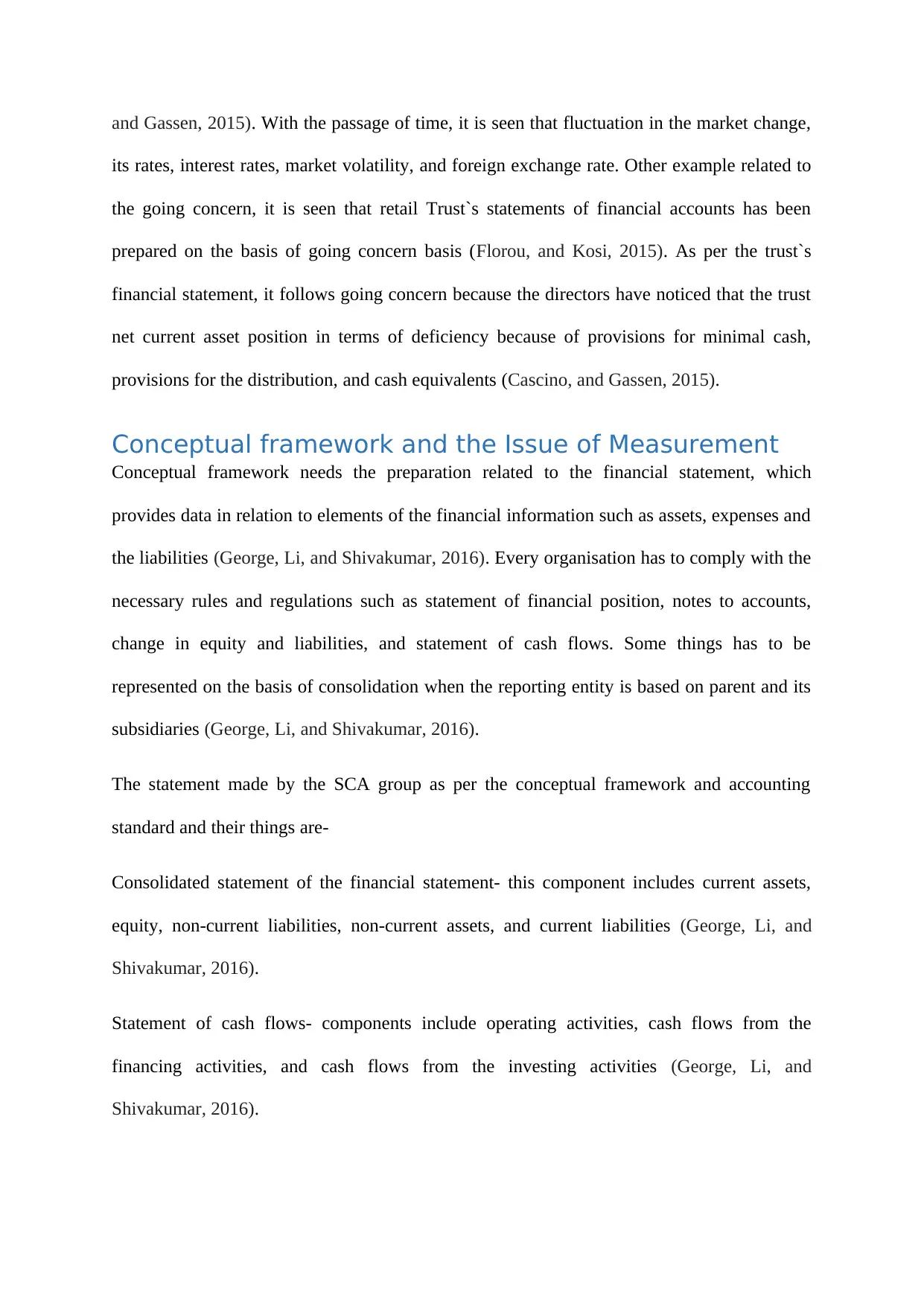
and Gassen, 2015). With the passage of time, it is seen that fluctuation in the market change,
its rates, interest rates, market volatility, and foreign exchange rate. Other example related to
the going concern, it is seen that retail Trust`s statements of financial accounts has been
prepared on the basis of going concern basis (Florou, and Kosi, 2015). As per the trust`s
financial statement, it follows going concern because the directors have noticed that the trust
net current asset position in terms of deficiency because of provisions for minimal cash,
provisions for the distribution, and cash equivalents (Cascino, and Gassen, 2015).
Conceptual framework and the Issue of Measurement
Conceptual framework needs the preparation related to the financial statement, which
provides data in relation to elements of the financial information such as assets, expenses and
the liabilities (George, Li, and Shivakumar, 2016). Every organisation has to comply with the
necessary rules and regulations such as statement of financial position, notes to accounts,
change in equity and liabilities, and statement of cash flows. Some things has to be
represented on the basis of consolidation when the reporting entity is based on parent and its
subsidiaries (George, Li, and Shivakumar, 2016).
The statement made by the SCA group as per the conceptual framework and accounting
standard and their things are-
Consolidated statement of the financial statement- this component includes current assets,
equity, non-current liabilities, non-current assets, and current liabilities (George, Li, and
Shivakumar, 2016).
Statement of cash flows- components include operating activities, cash flows from the
financing activities, and cash flows from the investing activities (George, Li, and
Shivakumar, 2016).
its rates, interest rates, market volatility, and foreign exchange rate. Other example related to
the going concern, it is seen that retail Trust`s statements of financial accounts has been
prepared on the basis of going concern basis (Florou, and Kosi, 2015). As per the trust`s
financial statement, it follows going concern because the directors have noticed that the trust
net current asset position in terms of deficiency because of provisions for minimal cash,
provisions for the distribution, and cash equivalents (Cascino, and Gassen, 2015).
Conceptual framework and the Issue of Measurement
Conceptual framework needs the preparation related to the financial statement, which
provides data in relation to elements of the financial information such as assets, expenses and
the liabilities (George, Li, and Shivakumar, 2016). Every organisation has to comply with the
necessary rules and regulations such as statement of financial position, notes to accounts,
change in equity and liabilities, and statement of cash flows. Some things has to be
represented on the basis of consolidation when the reporting entity is based on parent and its
subsidiaries (George, Li, and Shivakumar, 2016).
The statement made by the SCA group as per the conceptual framework and accounting
standard and their things are-
Consolidated statement of the financial statement- this component includes current assets,
equity, non-current liabilities, non-current assets, and current liabilities (George, Li, and
Shivakumar, 2016).
Statement of cash flows- components include operating activities, cash flows from the
financing activities, and cash flows from the investing activities (George, Li, and
Shivakumar, 2016).
⊘ This is a preview!⊘
Do you want full access?
Subscribe today to unlock all pages.

Trusted by 1+ million students worldwide
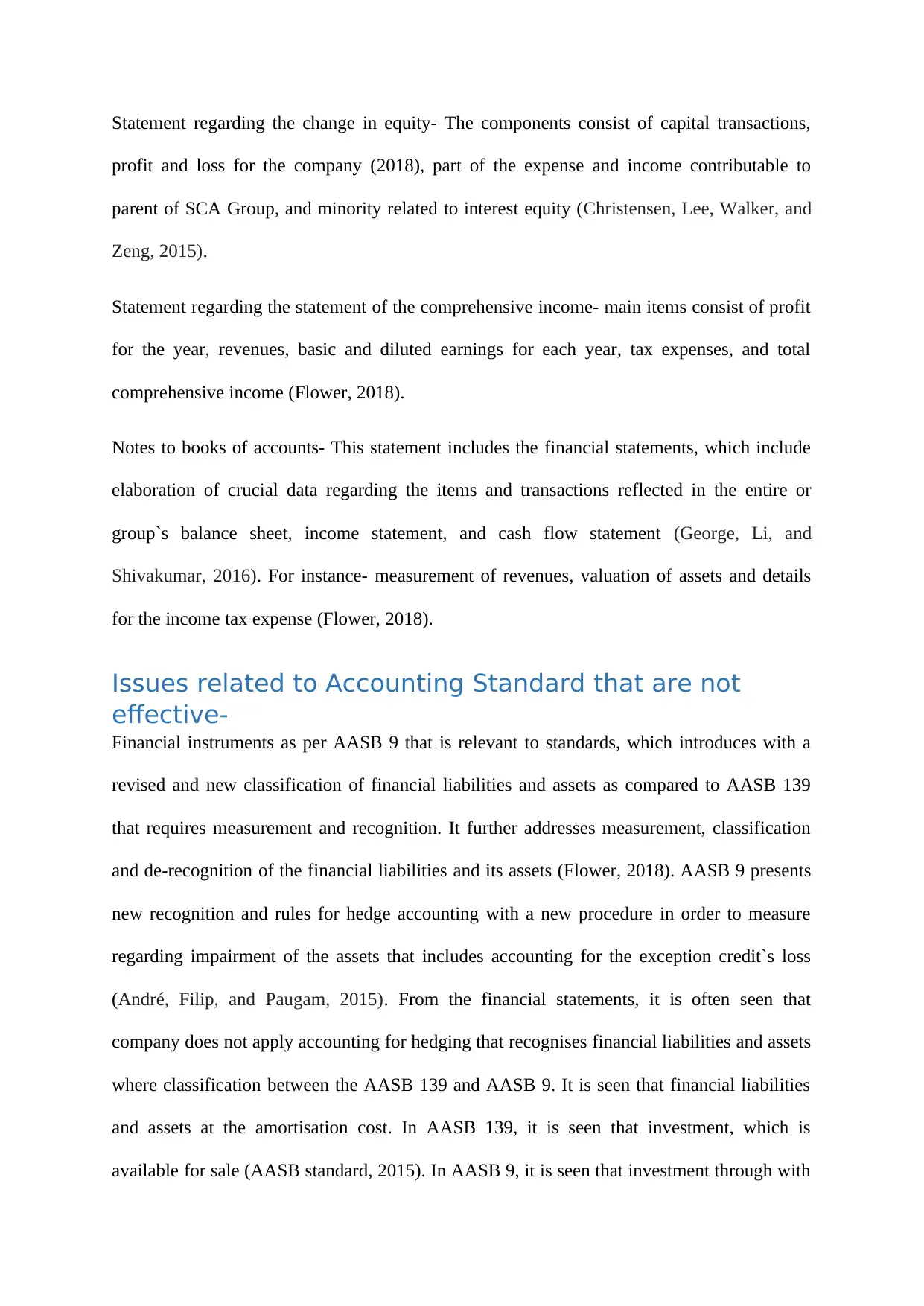
Statement regarding the change in equity- The components consist of capital transactions,
profit and loss for the company (2018), part of the expense and income contributable to
parent of SCA Group, and minority related to interest equity (Christensen, Lee, Walker, and
Zeng, 2015).
Statement regarding the statement of the comprehensive income- main items consist of profit
for the year, revenues, basic and diluted earnings for each year, tax expenses, and total
comprehensive income (Flower, 2018).
Notes to books of accounts- This statement includes the financial statements, which include
elaboration of crucial data regarding the items and transactions reflected in the entire or
group`s balance sheet, income statement, and cash flow statement (George, Li, and
Shivakumar, 2016). For instance- measurement of revenues, valuation of assets and details
for the income tax expense (Flower, 2018).
Issues related to Accounting Standard that are not
effective-
Financial instruments as per AASB 9 that is relevant to standards, which introduces with a
revised and new classification of financial liabilities and assets as compared to AASB 139
that requires measurement and recognition. It further addresses measurement, classification
and de-recognition of the financial liabilities and its assets (Flower, 2018). AASB 9 presents
new recognition and rules for hedge accounting with a new procedure in order to measure
regarding impairment of the assets that includes accounting for the exception credit`s loss
(André, Filip, and Paugam, 2015). From the financial statements, it is often seen that
company does not apply accounting for hedging that recognises financial liabilities and assets
where classification between the AASB 139 and AASB 9. It is seen that financial liabilities
and assets at the amortisation cost. In AASB 139, it is seen that investment, which is
available for sale (AASB standard, 2015). In AASB 9, it is seen that investment through with
profit and loss for the company (2018), part of the expense and income contributable to
parent of SCA Group, and minority related to interest equity (Christensen, Lee, Walker, and
Zeng, 2015).
Statement regarding the statement of the comprehensive income- main items consist of profit
for the year, revenues, basic and diluted earnings for each year, tax expenses, and total
comprehensive income (Flower, 2018).
Notes to books of accounts- This statement includes the financial statements, which include
elaboration of crucial data regarding the items and transactions reflected in the entire or
group`s balance sheet, income statement, and cash flow statement (George, Li, and
Shivakumar, 2016). For instance- measurement of revenues, valuation of assets and details
for the income tax expense (Flower, 2018).
Issues related to Accounting Standard that are not
effective-
Financial instruments as per AASB 9 that is relevant to standards, which introduces with a
revised and new classification of financial liabilities and assets as compared to AASB 139
that requires measurement and recognition. It further addresses measurement, classification
and de-recognition of the financial liabilities and its assets (Flower, 2018). AASB 9 presents
new recognition and rules for hedge accounting with a new procedure in order to measure
regarding impairment of the assets that includes accounting for the exception credit`s loss
(André, Filip, and Paugam, 2015). From the financial statements, it is often seen that
company does not apply accounting for hedging that recognises financial liabilities and assets
where classification between the AASB 139 and AASB 9. It is seen that financial liabilities
and assets at the amortisation cost. In AASB 139, it is seen that investment, which is
available for sale (AASB standard, 2015). In AASB 9, it is seen that investment through with
Paraphrase This Document
Need a fresh take? Get an instant paraphrase of this document with our AI Paraphraser
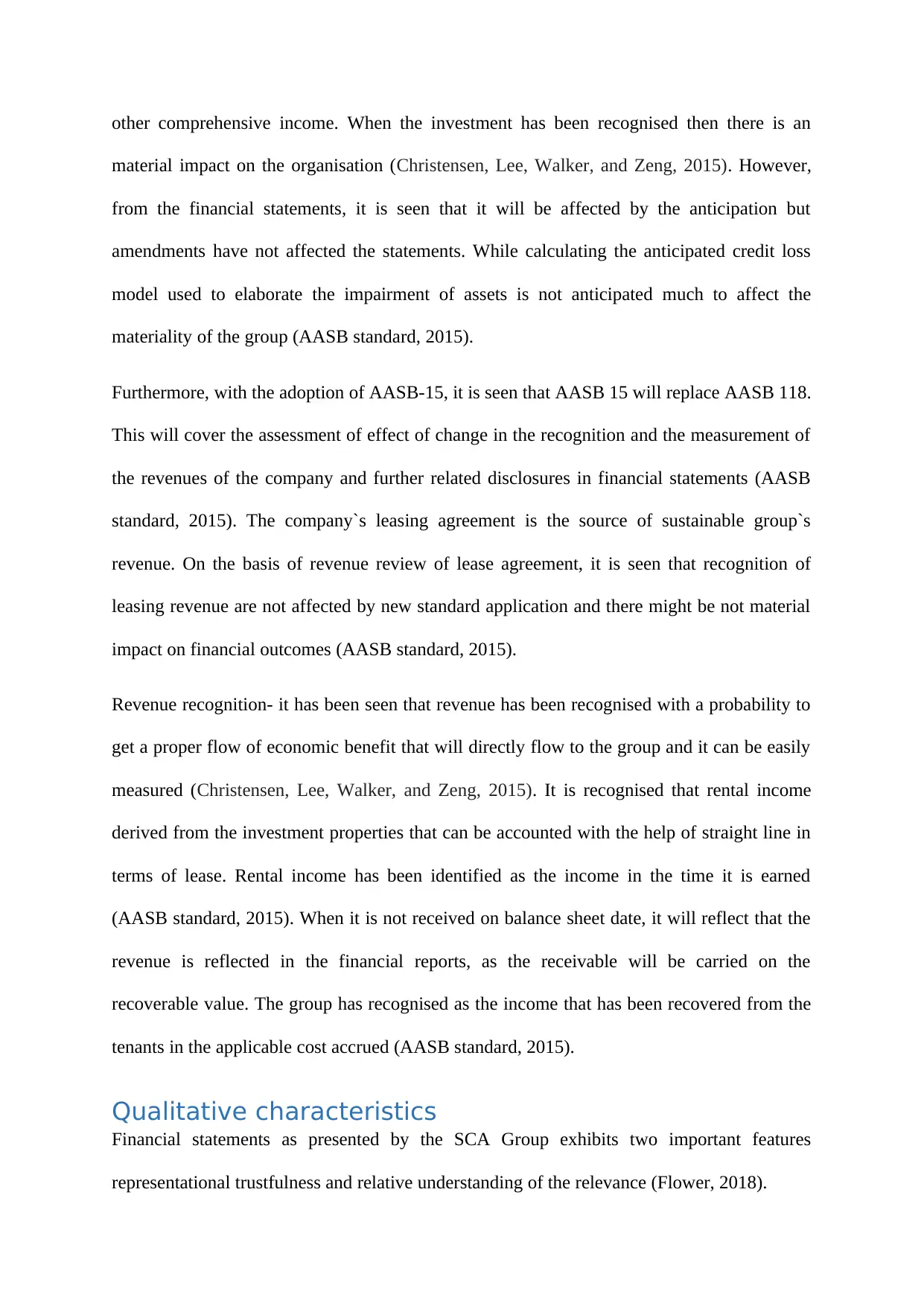
other comprehensive income. When the investment has been recognised then there is an
material impact on the organisation (Christensen, Lee, Walker, and Zeng, 2015). However,
from the financial statements, it is seen that it will be affected by the anticipation but
amendments have not affected the statements. While calculating the anticipated credit loss
model used to elaborate the impairment of assets is not anticipated much to affect the
materiality of the group (AASB standard, 2015).
Furthermore, with the adoption of AASB-15, it is seen that AASB 15 will replace AASB 118.
This will cover the assessment of effect of change in the recognition and the measurement of
the revenues of the company and further related disclosures in financial statements (AASB
standard, 2015). The company`s leasing agreement is the source of sustainable group`s
revenue. On the basis of revenue review of lease agreement, it is seen that recognition of
leasing revenue are not affected by new standard application and there might be not material
impact on financial outcomes (AASB standard, 2015).
Revenue recognition- it has been seen that revenue has been recognised with a probability to
get a proper flow of economic benefit that will directly flow to the group and it can be easily
measured (Christensen, Lee, Walker, and Zeng, 2015). It is recognised that rental income
derived from the investment properties that can be accounted with the help of straight line in
terms of lease. Rental income has been identified as the income in the time it is earned
(AASB standard, 2015). When it is not received on balance sheet date, it will reflect that the
revenue is reflected in the financial reports, as the receivable will be carried on the
recoverable value. The group has recognised as the income that has been recovered from the
tenants in the applicable cost accrued (AASB standard, 2015).
Qualitative characteristics
Financial statements as presented by the SCA Group exhibits two important features
representational trustfulness and relative understanding of the relevance (Flower, 2018).
material impact on the organisation (Christensen, Lee, Walker, and Zeng, 2015). However,
from the financial statements, it is seen that it will be affected by the anticipation but
amendments have not affected the statements. While calculating the anticipated credit loss
model used to elaborate the impairment of assets is not anticipated much to affect the
materiality of the group (AASB standard, 2015).
Furthermore, with the adoption of AASB-15, it is seen that AASB 15 will replace AASB 118.
This will cover the assessment of effect of change in the recognition and the measurement of
the revenues of the company and further related disclosures in financial statements (AASB
standard, 2015). The company`s leasing agreement is the source of sustainable group`s
revenue. On the basis of revenue review of lease agreement, it is seen that recognition of
leasing revenue are not affected by new standard application and there might be not material
impact on financial outcomes (AASB standard, 2015).
Revenue recognition- it has been seen that revenue has been recognised with a probability to
get a proper flow of economic benefit that will directly flow to the group and it can be easily
measured (Christensen, Lee, Walker, and Zeng, 2015). It is recognised that rental income
derived from the investment properties that can be accounted with the help of straight line in
terms of lease. Rental income has been identified as the income in the time it is earned
(AASB standard, 2015). When it is not received on balance sheet date, it will reflect that the
revenue is reflected in the financial reports, as the receivable will be carried on the
recoverable value. The group has recognised as the income that has been recovered from the
tenants in the applicable cost accrued (AASB standard, 2015).
Qualitative characteristics
Financial statements as presented by the SCA Group exhibits two important features
representational trustfulness and relative understanding of the relevance (Flower, 2018).
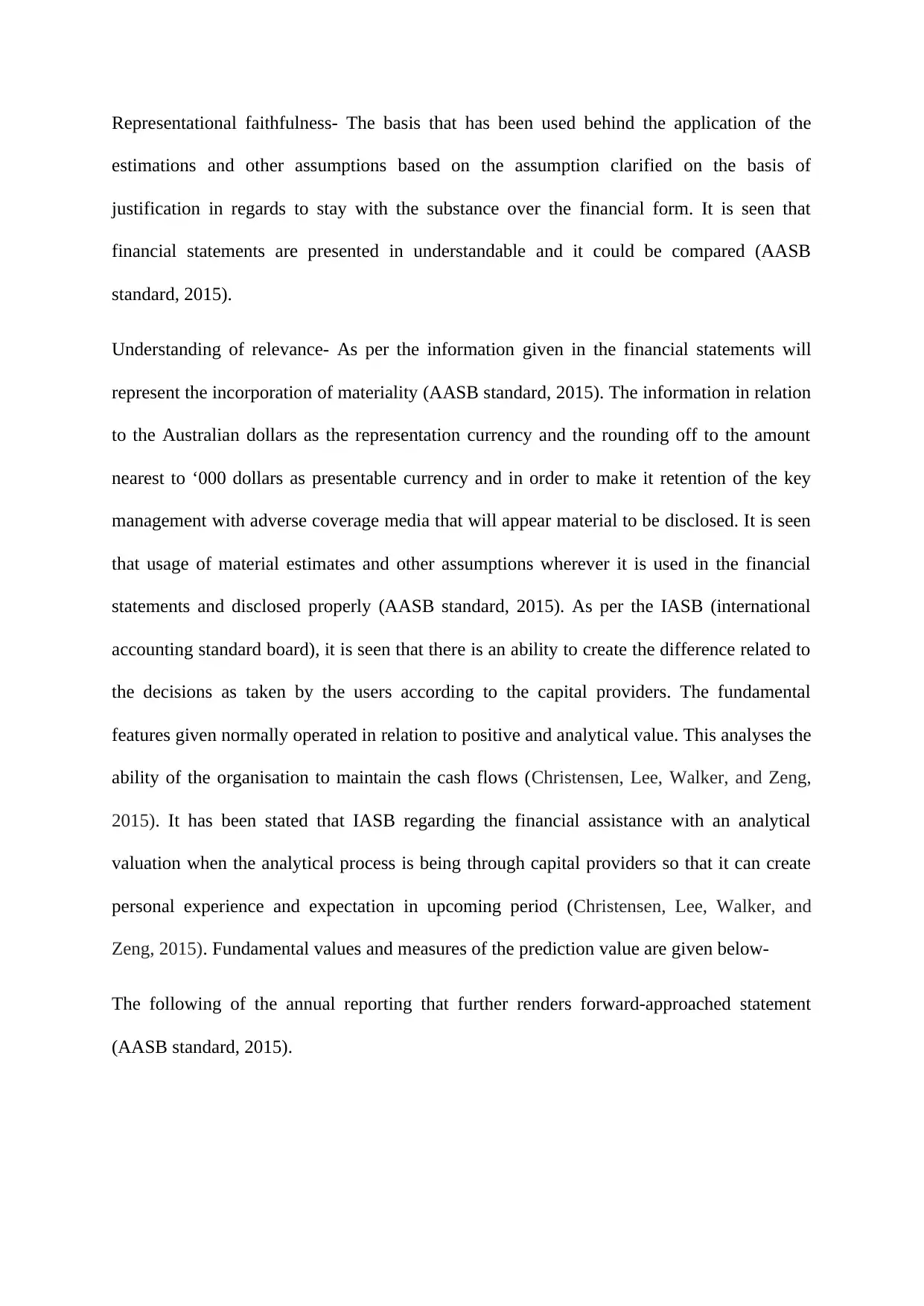
Representational faithfulness- The basis that has been used behind the application of the
estimations and other assumptions based on the assumption clarified on the basis of
justification in regards to stay with the substance over the financial form. It is seen that
financial statements are presented in understandable and it could be compared (AASB
standard, 2015).
Understanding of relevance- As per the information given in the financial statements will
represent the incorporation of materiality (AASB standard, 2015). The information in relation
to the Australian dollars as the representation currency and the rounding off to the amount
nearest to ‘000 dollars as presentable currency and in order to make it retention of the key
management with adverse coverage media that will appear material to be disclosed. It is seen
that usage of material estimates and other assumptions wherever it is used in the financial
statements and disclosed properly (AASB standard, 2015). As per the IASB (international
accounting standard board), it is seen that there is an ability to create the difference related to
the decisions as taken by the users according to the capital providers. The fundamental
features given normally operated in relation to positive and analytical value. This analyses the
ability of the organisation to maintain the cash flows (Christensen, Lee, Walker, and Zeng,
2015). It has been stated that IASB regarding the financial assistance with an analytical
valuation when the analytical process is being through capital providers so that it can create
personal experience and expectation in upcoming period (Christensen, Lee, Walker, and
Zeng, 2015). Fundamental values and measures of the prediction value are given below-
The following of the annual reporting that further renders forward-approached statement
(AASB standard, 2015).
estimations and other assumptions based on the assumption clarified on the basis of
justification in regards to stay with the substance over the financial form. It is seen that
financial statements are presented in understandable and it could be compared (AASB
standard, 2015).
Understanding of relevance- As per the information given in the financial statements will
represent the incorporation of materiality (AASB standard, 2015). The information in relation
to the Australian dollars as the representation currency and the rounding off to the amount
nearest to ‘000 dollars as presentable currency and in order to make it retention of the key
management with adverse coverage media that will appear material to be disclosed. It is seen
that usage of material estimates and other assumptions wherever it is used in the financial
statements and disclosed properly (AASB standard, 2015). As per the IASB (international
accounting standard board), it is seen that there is an ability to create the difference related to
the decisions as taken by the users according to the capital providers. The fundamental
features given normally operated in relation to positive and analytical value. This analyses the
ability of the organisation to maintain the cash flows (Christensen, Lee, Walker, and Zeng,
2015). It has been stated that IASB regarding the financial assistance with an analytical
valuation when the analytical process is being through capital providers so that it can create
personal experience and expectation in upcoming period (Christensen, Lee, Walker, and
Zeng, 2015). Fundamental values and measures of the prediction value are given below-
The following of the annual reporting that further renders forward-approached statement
(AASB standard, 2015).
⊘ This is a preview!⊘
Do you want full access?
Subscribe today to unlock all pages.

Trusted by 1+ million students worldwide
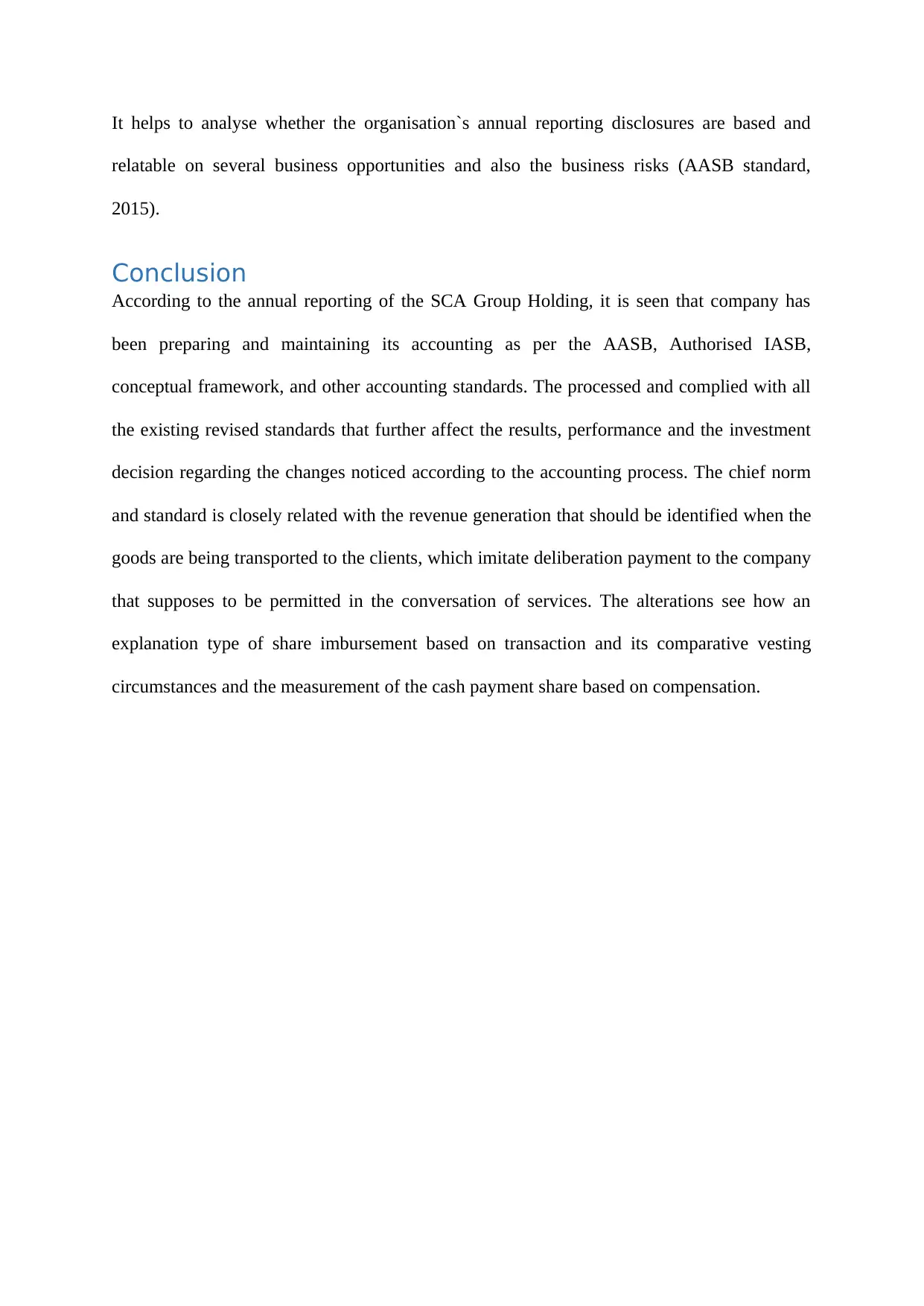
It helps to analyse whether the organisation`s annual reporting disclosures are based and
relatable on several business opportunities and also the business risks (AASB standard,
2015).
Conclusion
According to the annual reporting of the SCA Group Holding, it is seen that company has
been preparing and maintaining its accounting as per the AASB, Authorised IASB,
conceptual framework, and other accounting standards. The processed and complied with all
the existing revised standards that further affect the results, performance and the investment
decision regarding the changes noticed according to the accounting process. The chief norm
and standard is closely related with the revenue generation that should be identified when the
goods are being transported to the clients, which imitate deliberation payment to the company
that supposes to be permitted in the conversation of services. The alterations see how an
explanation type of share imbursement based on transaction and its comparative vesting
circumstances and the measurement of the cash payment share based on compensation.
relatable on several business opportunities and also the business risks (AASB standard,
2015).
Conclusion
According to the annual reporting of the SCA Group Holding, it is seen that company has
been preparing and maintaining its accounting as per the AASB, Authorised IASB,
conceptual framework, and other accounting standards. The processed and complied with all
the existing revised standards that further affect the results, performance and the investment
decision regarding the changes noticed according to the accounting process. The chief norm
and standard is closely related with the revenue generation that should be identified when the
goods are being transported to the clients, which imitate deliberation payment to the company
that supposes to be permitted in the conversation of services. The alterations see how an
explanation type of share imbursement based on transaction and its comparative vesting
circumstances and the measurement of the cash payment share based on compensation.
Paraphrase This Document
Need a fresh take? Get an instant paraphrase of this document with our AI Paraphraser
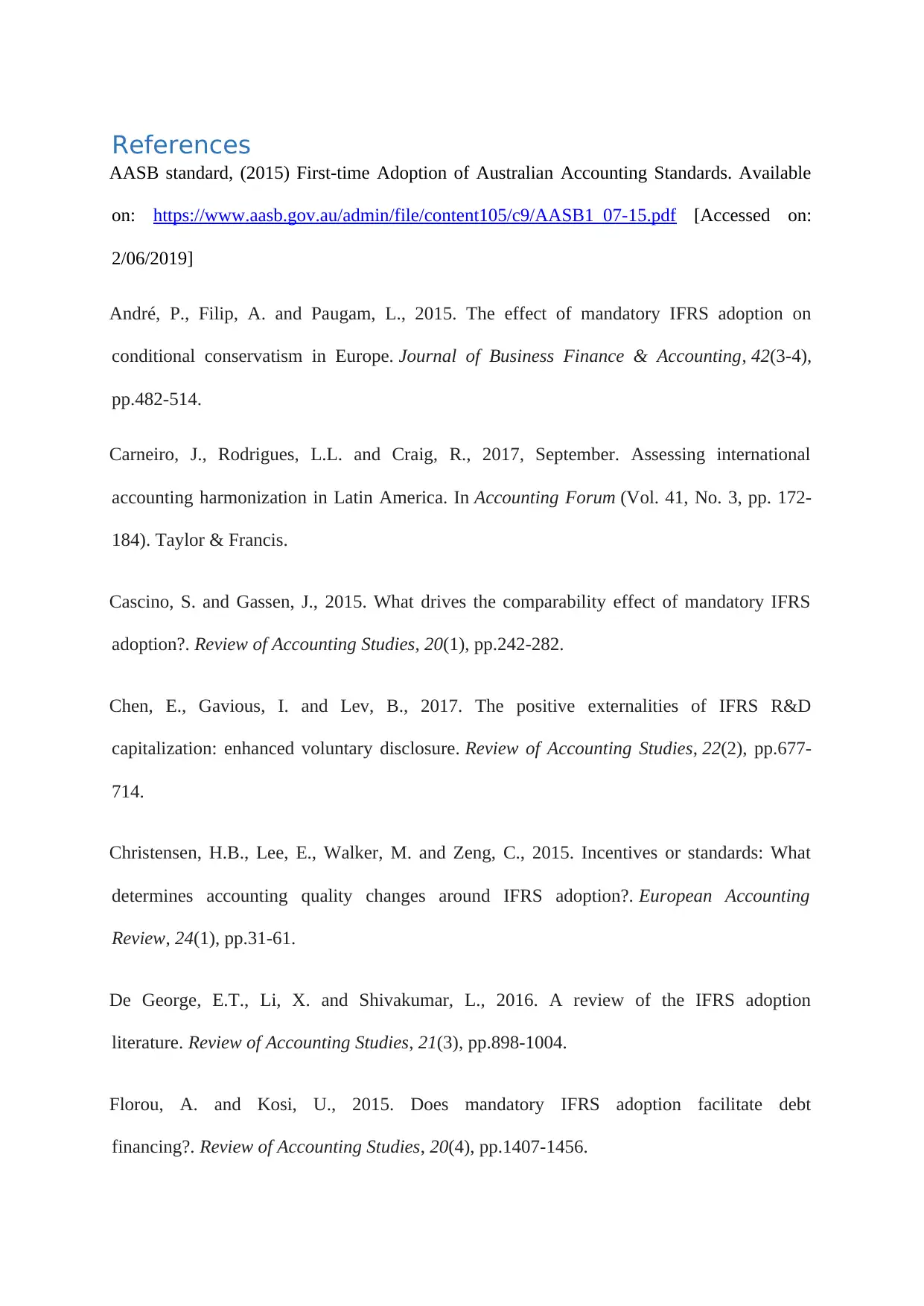
References
AASB standard, (2015) First-time Adoption of Australian Accounting Standards. Available
on: https://www.aasb.gov.au/admin/file/content105/c9/AASB1_07-15.pdf [Accessed on:
2/06/2019]
André, P., Filip, A. and Paugam, L., 2015. The effect of mandatory IFRS adoption on
conditional conservatism in Europe. Journal of Business Finance & Accounting, 42(3-4),
pp.482-514.
Carneiro, J., Rodrigues, L.L. and Craig, R., 2017, September. Assessing international
accounting harmonization in Latin America. In Accounting Forum (Vol. 41, No. 3, pp. 172-
184). Taylor & Francis.
Cascino, S. and Gassen, J., 2015. What drives the comparability effect of mandatory IFRS
adoption?. Review of Accounting Studies, 20(1), pp.242-282.
Chen, E., Gavious, I. and Lev, B., 2017. The positive externalities of IFRS R&D
capitalization: enhanced voluntary disclosure. Review of Accounting Studies, 22(2), pp.677-
714.
Christensen, H.B., Lee, E., Walker, M. and Zeng, C., 2015. Incentives or standards: What
determines accounting quality changes around IFRS adoption?. European Accounting
Review, 24(1), pp.31-61.
De George, E.T., Li, X. and Shivakumar, L., 2016. A review of the IFRS adoption
literature. Review of Accounting Studies, 21(3), pp.898-1004.
Florou, A. and Kosi, U., 2015. Does mandatory IFRS adoption facilitate debt
financing?. Review of Accounting Studies, 20(4), pp.1407-1456.
AASB standard, (2015) First-time Adoption of Australian Accounting Standards. Available
on: https://www.aasb.gov.au/admin/file/content105/c9/AASB1_07-15.pdf [Accessed on:
2/06/2019]
André, P., Filip, A. and Paugam, L., 2015. The effect of mandatory IFRS adoption on
conditional conservatism in Europe. Journal of Business Finance & Accounting, 42(3-4),
pp.482-514.
Carneiro, J., Rodrigues, L.L. and Craig, R., 2017, September. Assessing international
accounting harmonization in Latin America. In Accounting Forum (Vol. 41, No. 3, pp. 172-
184). Taylor & Francis.
Cascino, S. and Gassen, J., 2015. What drives the comparability effect of mandatory IFRS
adoption?. Review of Accounting Studies, 20(1), pp.242-282.
Chen, E., Gavious, I. and Lev, B., 2017. The positive externalities of IFRS R&D
capitalization: enhanced voluntary disclosure. Review of Accounting Studies, 22(2), pp.677-
714.
Christensen, H.B., Lee, E., Walker, M. and Zeng, C., 2015. Incentives or standards: What
determines accounting quality changes around IFRS adoption?. European Accounting
Review, 24(1), pp.31-61.
De George, E.T., Li, X. and Shivakumar, L., 2016. A review of the IFRS adoption
literature. Review of Accounting Studies, 21(3), pp.898-1004.
Florou, A. and Kosi, U., 2015. Does mandatory IFRS adoption facilitate debt
financing?. Review of Accounting Studies, 20(4), pp.1407-1456.
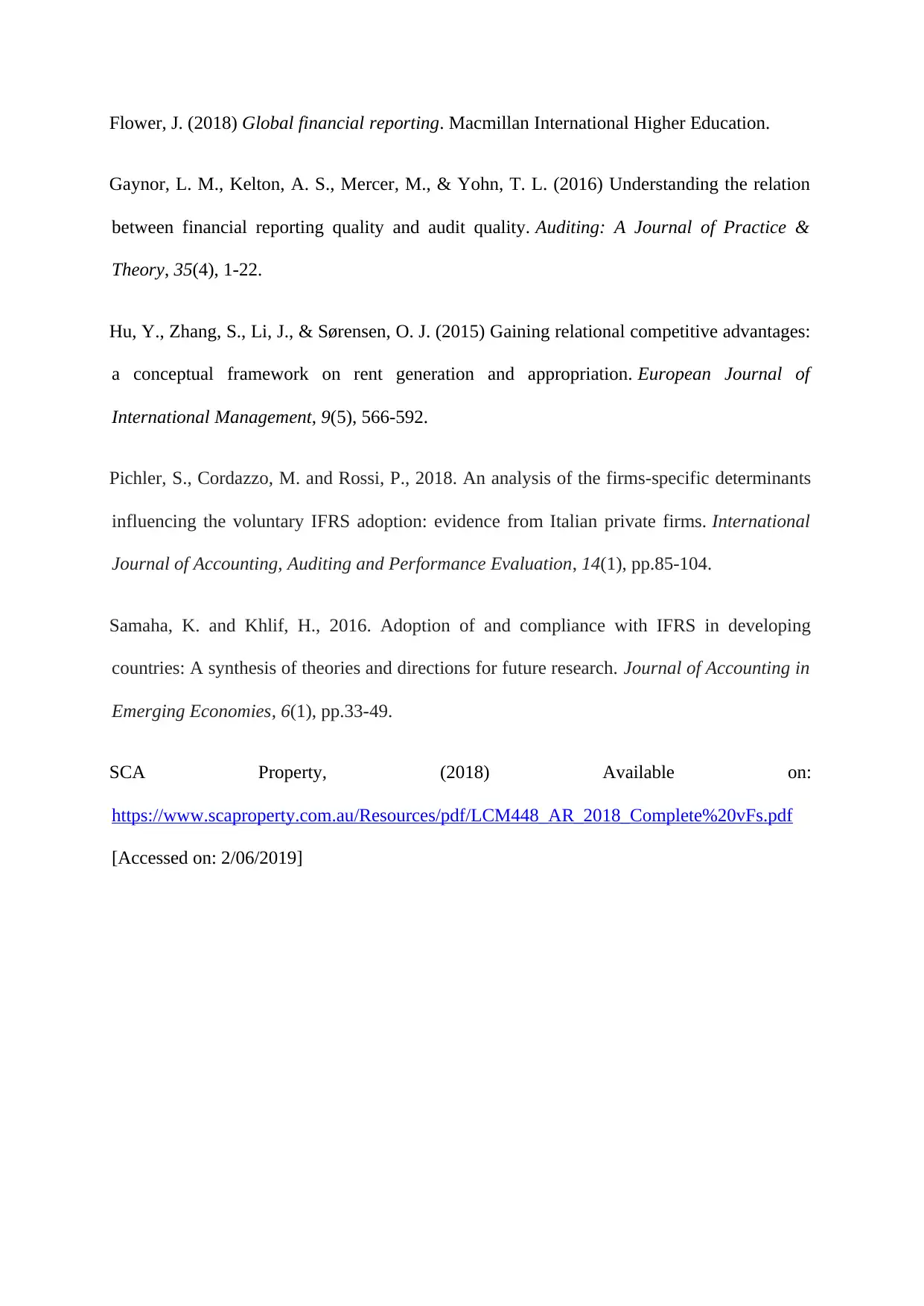
Flower, J. (2018) Global financial reporting. Macmillan International Higher Education.
Gaynor, L. M., Kelton, A. S., Mercer, M., & Yohn, T. L. (2016) Understanding the relation
between financial reporting quality and audit quality. Auditing: A Journal of Practice &
Theory, 35(4), 1-22.
Hu, Y., Zhang, S., Li, J., & Sørensen, O. J. (2015) Gaining relational competitive advantages:
a conceptual framework on rent generation and appropriation. European Journal of
International Management, 9(5), 566-592.
Pichler, S., Cordazzo, M. and Rossi, P., 2018. An analysis of the firms-specific determinants
influencing the voluntary IFRS adoption: evidence from Italian private firms. International
Journal of Accounting, Auditing and Performance Evaluation, 14(1), pp.85-104.
Samaha, K. and Khlif, H., 2016. Adoption of and compliance with IFRS in developing
countries: A synthesis of theories and directions for future research. Journal of Accounting in
Emerging Economies, 6(1), pp.33-49.
SCA Property, (2018) Available on:
https://www.scaproperty.com.au/Resources/pdf/LCM448_AR_2018_Complete%20vFs.pdf
[Accessed on: 2/06/2019]
Gaynor, L. M., Kelton, A. S., Mercer, M., & Yohn, T. L. (2016) Understanding the relation
between financial reporting quality and audit quality. Auditing: A Journal of Practice &
Theory, 35(4), 1-22.
Hu, Y., Zhang, S., Li, J., & Sørensen, O. J. (2015) Gaining relational competitive advantages:
a conceptual framework on rent generation and appropriation. European Journal of
International Management, 9(5), 566-592.
Pichler, S., Cordazzo, M. and Rossi, P., 2018. An analysis of the firms-specific determinants
influencing the voluntary IFRS adoption: evidence from Italian private firms. International
Journal of Accounting, Auditing and Performance Evaluation, 14(1), pp.85-104.
Samaha, K. and Khlif, H., 2016. Adoption of and compliance with IFRS in developing
countries: A synthesis of theories and directions for future research. Journal of Accounting in
Emerging Economies, 6(1), pp.33-49.
SCA Property, (2018) Available on:
https://www.scaproperty.com.au/Resources/pdf/LCM448_AR_2018_Complete%20vFs.pdf
[Accessed on: 2/06/2019]
⊘ This is a preview!⊘
Do you want full access?
Subscribe today to unlock all pages.

Trusted by 1+ million students worldwide
1 out of 12
Related Documents
Your All-in-One AI-Powered Toolkit for Academic Success.
+13062052269
info@desklib.com
Available 24*7 on WhatsApp / Email
![[object Object]](/_next/static/media/star-bottom.7253800d.svg)
Unlock your academic potential
Copyright © 2020–2025 A2Z Services. All Rights Reserved. Developed and managed by ZUCOL.




